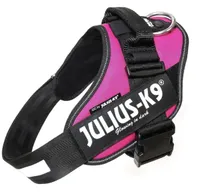Does your dog hate wearing a harness? This trainer's simple advice is just what you need
If your pup is not a harness fan, why not try this advice out?

Does your dog enjoy wearing their harness?
Not all dogs do, but it’s a good idea to get your pup used to wearing various types of gear, as it can come in useful and help keep them safe. They’re often more comfortable than collars too, so investing in the best dog harness for your pup might not be a bad idea.
But, how can you get your pup more comfortable with their harness? Fortunately, Juliana DeWillems, owner and head trainer at JW Dog Training & Behavior, has offered some advice in a new Instagram post, and we think it’s well worth reading!
A post shared by JW Dog Training & Behavior Consulting (@jwdogtraining)
A photo posted by on
In her video, DeWillems is working with a dog who doesn’t enjoy wearing a harness — as soon as his human gets the harness out, he’d usually run away. So, she’s trying to get him more comfortable with the harness through a training session.
DeWillems is using a clicker, and every time the dog looks at the harness or moves toward it, she clicks and gives him a treat. “I’m not cueing him to interact with the harness,” she explains. “Instead, I’m letting it be completely his choice and I’m rewarding any small snippet of him choosing to approach it, taking very small but frequent steps toward my end goal.”
Sometimes, she’ll toss the treat away from the harness after she clicks, which gives him a chance to move away and choose to re-engage with the training session. She also moves away herself every few reps, which gives him the opportunity to practice moving into and towards the harness.
Do you want to know why your dog hates their harness and how to encourage them to use it? Well, DeWillems explains that the approach she’s taking to the training is designed to eliminate or reduce the pressure he feels to interact with the harness, because this is what can cause negative associations and affect progress.
Get the best advice, tips and top tech for your beloved Pets
Maybe you’re asking how tight should a harness be, too? If a dog is used to wearing harnesses that are too tight, this might make them not want to wear them again in the future.
“By working at his pace, giving him agency, and not pushing him beyond his ability to cope, we’re more likely to make progress long-term,” she continues. “It’s important to note that in between this type of trust-building training, I’m not forcing the harness on him at any time, and instead we have opted to walk him on a comfortable flat collar.”
She explains that it’s not ideal, because she prefers to use a harness when it comes to walks, but it allows them to work at the dog’s pace on the training, but still get out and meet his needs.
When your pup does get used to their harness, is it safe to leave a harness on a dog all the time? As it turns out, you can do this on occasion — but there are risks, so don’t leave your dog unsupervised in their harness for too long!
Julius-K9 IDC Powerharness Nylon Reflective No Pull Dog Harness
$36 at Chewy
Sturdy and easy to use, this powerhouse of a harness features a breathable lining for comfort and reflective chest straps and side labels for maximum visibility.

Adam is a freelance journalist specialising in pets, music and culture, and mental health and wellbeing. He investigates and writes the large majority of news on PetsRadar, and collaborates with veterinary experts to produce informative pet care content.
Adam has a journalism degree from Southampton Solent University and a masters degree in Magazine Journalism from Cardiff University. He was previously senior editor at dog advice website DogTime.com, and has also written for The Independent, GoodToKnow and Healthline.
He owns two rescue cats, Bunny and Dougie, and has also previously had a rabbit, fish and Roborovski dwarf hamsters.

